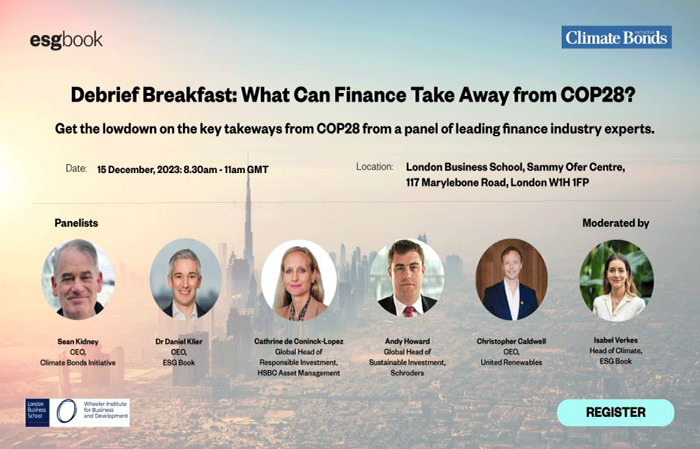How might COP28 impact global finance? Last week, the Wheeler Institute for Business and Development hosted ‘COP28 debrief breakfast: what can finance take away from COP28?’, in collaboration with ESG Book and the Climate Bonds Initiative, to explore some possible answers.

Characterised by a sense of urgency and a challenging economic environment, COP28 marked a significant step in the global response to climate change. The call for action was louder and clearer than ever as the world reacted to the seventh consecutive hottest year on record.
What are the implications for finance? Will COP change the financial system, permitting flows of capital from where they are to where they are needed? Isabel Verkes, Head of Climate Research at ESG Book, was joined by Sean Kidney, CEO at the Climate Bonds Initiative; Cathrine de Coninck-Lopez (LBS EMBA 2016), Global Head of Responsible Investment at HSBC Asset Management; Andy Howard, Global Head of Sustainable Investment at Schroders; and Christopher Caldwell (LBS MBA 2011), CEO at United Renewables to shed some light.
Key outcomes of COP28
The agreement to begin reducing global consumption of fossil fuels was among the most notable outcomes. Even though the agreement recorded the intention to triple renewable energy production by 2030 and a financial commitment to the loss and damage fund, many countries viewed the deal as insufficient to meet the escalating challenges posed by global warming. The consensus among the speakers was that COP28 was a step in the right direction, though it was not entirely positive.
Sean Kidney emphasised the power of symbolism and signalling in politics, as the involvement of countries like the U.S., China, Europe, India, and Japan as well as the world’s biggest banks in the transition to sustainable practices indicated a significant shift in the world economy. He summarised, ‘The super tanker of the world economy is turning.’
The role and future of fossil fuels
There was general agreement that though significant progress has been made in terms of grand statements about reducing fossil fuel usage, a gap remains in translating these into actionable policies. Andy Howard noted that the pace of policy implementation to phase out fossil fuels has slowed. On a positive note, he added, an increasing number of companies have set net-zero targets, which indicates a growing commitment to the transition from the private sector. The number of such companies has risen by 40% from 702 in June 2022 to 1,003 in October 2023, according to the Net Zero Tracker.
The panel also discussed the role of the oil and gas industry in this transition. While it was highlighted that the process is now inevitable, the shift does not necessarily require these companies to directly engage in renewable energy projects. Rather, the focus should be on whether they can efficiently operate and develop renewable assets or whether capital should be redistributed to shareholders for alternative investments.
Christopher Caldwell believes that solutions like Carbon Capture and Storage (CCS) are not immediate game-changers, though they are important. Indeed, a recent study found that when adjusted for the energy consumption requested to capture and store CO2, CCS emission reduction capacity is limited to 10-11% and not the promised 80-90%. The emphasis should be on demand-side changes and diversification in economies towards renewable energy.
The panel emphasised that thus far, COP conferences have not significantly impacted renewable energy development and that strong institutional regulation and supportive planning systems are required to facilitate this transition.
The Role of Investors and Finance in the Energy Transition
Catherine de Coninck-Lopez highlighted three primary areas of focus in responsible investment: research, stewardship, and product development. Research involves integrating complex environmental and carbon data into investment processes. Stewardship emphasises engagement with companies to meet targets on critical issues like chemical and energy use. And product development is about crafting innovative financial products, such as transition green bonds, which are pivotal in supporting climate change initiatives. Notably, this area has shown remarkable growth. According to Morningstar data, assets under the management of climate funds have increased to over $500 billion, making up almost 20% of the global sustainable funds landscape.
Kidney underscored a growing trend in the fixed income market towards thematic issuance of green bonds, serving as a crucial signalling mechanism for companies’ commitments to sustainability. This shift is prominent in regions where transition plans are mandatory, such as Europe, the UK, Japan, and the Philippines. This approach is particularly relevant for companies in industries like steel and cement, which, despite current underperformance in sustainability metrics, hold potential for alignment with environmental goals.
Andy Howard added that there is often no trade-off between sustainable investing and generating returns. Companies that are leading in emissions reduction generated better returns for their investors compared to sector peers. This illustrates that the market ‘rewards firms capable of transitioning,’ not just for their higher market value but for their profitability.
The panel also delved into the topic of engagement versus divestment in sectors like oil and gas. While industries such as coal may be less susceptible to an activist investing approach, oil and gas companies still have the potential to transform, thereby presenting opportunities for investors. The panellists emphasised how significant the role of investors is in influencing companies’ policies and practices. Engaging with companies on climate issues has resulted in greater substantial emissions reductions and improved financial performance, challenging the conventional view of fund managers as passive stock pickers. It was concluded that ‘transition is probably the best way of unlocking returns from both an investment and from a society point of view.’
Challenges and Opportunities in Emerging Markets
Key differences between developed economies and emerging markets lie in the nature and ambition of transition plans, timelines, and the level of disclosure that companies are willing or able to provide.
Catherine suggested that informed sustainable investment decisions in emerging markets require robust assessment frameworks to gauge the credibility of the transition plans in emerging economies, a task complicated by constantly changing policies, expectations, and local requirements. Nonetheless, she added that a notable shift is already being observed as emerging markets are becoming increasingly attractive investment destinations due to new requirements for better disclosure. Historically underappreciated due to a lack of transparency, these markets are now poised to gain more attention from indices and rating agencies.
The discussion also touched upon the need for a more straightforward approach to assisting emerging economies in their transition efforts. A case in point is Colombia, which, despite its non-proliferation of fossil fuels and commitment to keep its coal reserves unexploited, faced downgrades from rating agencies. The transition away from fossil fuels in Colombia appears to be especially challenging, considering the country’s rising debt costs and the fact that over the past decade, oil taxes, dividends, and royalties have accounted for 13% of government revenue. This situation mirrors Ecuador’s 2007 challenge, when it unsuccessfully tried to raise $3.6 billion to keep oil reserves untouched, only managing to secure a small fraction of the required funds. These instances underscore the critical need for revising global economic rules to effectively support climate transition in developing countries.
Carbon Markets and Carbon Capture: a distraction or a potential solution
The last topic of discussion involved the debatable nature of carbon credits, as some often claim that carbon credits are an unreliable tool that allows emitters to financially offset their emissions without actually reducing their polluting activities. Yet despite the absence of a new framework and controversies, the potential of these credit markets remains significant. In fact, according to the Institute for Management Development (IMD), voluntary carbon markets and nature-based solutions currently account for a small percent of climate financing, yet they could contribute about 30% of the emission reductions needed to meet the goals set out by The Paris Agreement. This finding certainly highlights a major opportunity for growth and efficiency in emission reduction strategies.
Andrew Howard noted that carbon markets face challenges in terms of credibility and integrity. The foundations laid at COP26 were a missed opportunity to provide structure for these markets and set prices on carbon to ensure a fair transition without compromising global competitiveness, he said. The urgent need for accelerated solutions is further highlighted by the research from McKinsey, which found that growing demand for carbon offsets could potentially increase 10 to 15 times based on current company commitments. Carbon markets are not the sole answer to climate change but are increasingly recognised as a crucial tool in expediting solutions.
Christophe Caldwell also underscored a growing acceptance of the carbon credit system as an integral part of the global response to climate change. For instance, the European Union’s Carbon Border Adjustment Mechanism (CBAM) received no significant pushback, suggesting its potential role in the international trade system along with similar initiatives in Japan, Korea, and Australia.
Lastly, the question regarding the effectiveness of Carbon Capture, Utilisation, and Storage (CCUS) was addressed, as this approach is sometimes seen as a distraction from other green initiatives. The general idea was summarised by Sean who stated that ‘we need to do everything we can to keep emissions down,’ indicating that CCUS alone is not the panacea, yet it is indispensable in the transition towards a lower-carbon future. It was argued that, if technological advancements make it an economically viable solution, CCUS could play a significant role, particularly in sectors such as steel and cement production, where emissions are notoriously difficult to abate.
About the author

Vitaly Zakalskiy (LBS MiM 2024) is an Outreach and Communications Intern at the Wheeler Institute for Business and Development. Vitaly holds a BSc in Economics & Politics from the London School of Economics. He has experience in strategy consulting and research in the field of business strategy in emerging markets.
About the collaborators
ESG Book combines cutting edge technology and proprietary research to fix a fundamental problem; markets need clearer ESG information to allocate finance efficiently to more sustainable outcomes. Their solutions make sustainability data more widely available and comparable for all market stakeholders. They enable companies to be custodians of their own data, provide framework-neutral ESG information in real-time, and promote transparency through our digital platform.
The Climate Bonds Initiative is an international organisation working to mobilise global capital for climate action. They achieve this through the development of the Climate Bonds Standard and Certification Scheme, Policy Engagement and Market Intelligence work. They empower our Partner organisations with the tools and knowledge needed to navigate, influence and instigate change.
Discover our research portal and subscribe to our mailing list now
